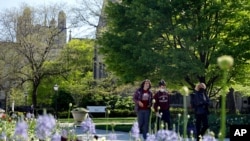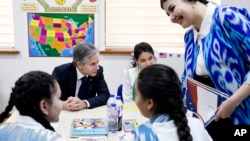Student Union
For Some Universities, Fall Semester Uncertain as Coronavirus Persists Globally

The U.S. government’s pumping of $35 billion into emergency aid for college students has not been enough for some universities, say education experts.
They cite drastically lower enrollments even as things appear to be shifting back to normal after more than a year of the coronavirus pandemic.
“Enrollments are down quite significantly, both at the public institutions and the community colleges, nationwide,” said Todd Sedmak, manager of corporate communications at National Student Clearinghouse (NSC), a nonprofit organization that crunches education data.
“This decrease in enrollment has led to less money coming to universities from tuition and fees,” he said.
Declines in enrollment occurred because of the coronavirus pandemic, which shut down campuses in March 2020. Students switched to remote learning, while others deferred enrollment: Online learning, coupled with the cost of college — was not worth it for many students.
Among international students, enrollment decreased 43% for the fall 2020 semester, according to the Institute of International Education (IIE). Among American students, enrollments declined 2.5% in fall 2020, nearly twice the rate of enrollment decline reported in fall 2019, NSC reported.
The fiscal contribution from international students to the U.S. economy in the 2019-2020 academic year was $38.7 billion, down $1.8 billion (4.4%), Rachel Banks, senior director of public policy and legislation at NAFSA: Association of International Educators, wrote in an email to VOA.
The savings from colleges and universities not operating study abroad programs during the pandemic partially offset the financial loss of fewer enrollments, said Catharine Hill, managing director of Ithaka S+R, an organization looking to broaden access to higher education and reduce costs.
But overall, said Lynn Pasquerella, president of American Association of Colleges and Universities (AAC&U), the pandemic’s economic toll on U.S. universities and colleges has been huge.
Some colleges have closed, unable to weather the economic storm. Banks pointed to Becker College in Massachusetts, Mills College in California, and Concordia College in New York as examples, writing that they “have had to shut their doors because the pandemic exacerbated their existing financial troubles.”
As for students who suddenly find themselves without a college or university to attend, Federal Student Aid (FSA), an office of the U.S. Department of Education, lists options.
Students may transfer to another university to finish their program of study. Some closing institutions offer what is called a teach out, which is a specific contract with another institution for students to fulfill their studies to graduate.
Concordia College in Bronxville, New York, agreed to a formal agreement with nearby Iona College in New Rochelle, New York, to provide continued education for Concordia’s students. Iona will purchase Concordia’s leafy Bronxville campus.
Graduating international students at Concordia who hold F-1 student visas will be protected by a transfer of records to Concordia University in St. Paul, Minnesota, according to the university website. The university will be a custodian of the student’s records, allowing the Designated School Official (DSO) there to manage students who have been approved for Optional Practical Training (OPT), a popular work-permit program for international students.
For U.S. citizens who decide not to continue their education immediately, they can try to discharge their federal student loans, meaning some or all of the money is not repaid.
For international students, school closures could threaten their visa status. Students are encouraged to speak to their school’s designated official for the Department of Homeland Security’s Student and Exchange Visitor Program (SEVP).
According to U.S. Immigrations and Customs Enforcement, schools will retain access to the Student and Exchange Visitor Information System (SEVIS) to transfer and maintain student records until a date set by SEVP, upon which SEVP will terminate the student’s SEVIS records.
Active nonimmigrant students or students in initial status who have already entered the U.S. after being cleared to do so can transfer to another SEVP-certified institution, change their visa status or leave the country, according to ICE.
In terms of what the fall semester will look like for international students in the U.S., Ithaka S+R’s Hill said uncertainty still exists.
“I think there'll still be some problems with international students just because other countries are not getting vaccinated as quickly,” she said. “So, I'm not quite sure what they'll do there ... have a negative test before they leave, bring them back, have them quarantine for two weeks, and then get the vaccine.”
Hill also said she hoped domestic students “can come back.”
Pasquerella acknowledged that in addition to the schools of higher learning, students have had to face hardships during the pandemic.
“For decades, we've been talking about how the current financial model for higher education is unsustainable; we can't continue to have increasing tuition, burgeoning loan burdens for students, especially at a time when job prospects for college graduates are uncertain,” she said.
To best help students, Pasquerella said, reinvestment in higher education is needed. That way, she said, it would be seen as a public good, rather than a private commodity. Hill noted that the Biden administration’s proposal to double the Pell Grant would be helpful.
A federal Pell Grant does not have to be repaid. The maximum Pell Grant for 2015–2016 was $5,775. The amount depends on the costs to attend school, a person’s financial need, status as a full- or part-time student, and plans to attend school for a full academic year or less, according to the U.S. Department of Education.
Hill said she is still worried about the pandemic’s effect on lower-income students.
“I do worry that low-income families have been so disrupted that getting students to college — I mean, even if the economy comes back, if you've been out of the labor market for a year, [it] takes a little longer to recover from that,” she told VOA.
“The higher your income, the more likely that you actually still had some in-person classes or effective synchronous online classes,” Hill said. “And the lower your income, the more likely that you've just missed out on a good part of your high school education. And that's going to put students in a very different position when it's time to go to college.”
While the coronavirus and its variants remain global, Banks said enrollment was up from last year’s significant losses.
The Common App, a standardized application to colleges and universities, showed that as of February 15, the volume of international applicants to U.S. colleges and universities for Fall 2021 had increased by about 13% over the prior year.
The countries that send the most students are showing increases, Banks said, with the exception of China.
“Although applications from China are down by 18% from last year, there are large increases in applicants from other countries including India (+28%), Canada (+22%), Nigeria (+12%), Pakistan (+37%), the United Kingdom (+23%), and Brazil (+41%),” she wrote.
See all News Updates of the Day
- By VOA News
Michigan State international students get their own space

Michigan State University in East Lansing, Michigan, is setting aside a space in the International Center for international students.
Nidal Dajani, vice president of the school's International Student Association, said that the club plans to use the space to host events and hopes to collaborate with other student groups.
- By Dylan Ebs
International students find community during Pride Month

For LGBTQ+ international students, Pride Month, observed in June, is a unique time to reflect.
They hold on to multiple identities — both their LGBTQ+ identity and their cultural background — but coming to terms with them is not always easy.
For graduate student David Zhou, these identities can feel conflicting as transgender rights in China remain a controversial issue and spaces for LGBTQ people close. Zhou, 25, is transgender and pursuing an education in the STEM field at an urban university in the Midwestern United States.
VOA is using a pseudonym for Zhou’s first name and is not naming his university to protect his identity due to safety concerns back home in China. Zhou is not open about his transgender identity to his family.
During Pride Month, Zhou said he attended multiple LGBTQ+ events in his community and is surrounded by a supportive group of LGBTQ+ students who can relate to his experiences. But he’s not open about his identity to everyone on campus and said he doesn’t disclose his preferred pronouns to everyone to avoid transphobic comments.
“I feel like I have to make some judgments of the character of that person to see if they’re a good person to disclose [my identity] to,” Zhou said.
Zhou’s Pride Month celebrations included attending local markets with LGBTQ+ vendors and hanging out with his LGBTQ+ friends.
“They normalized being trans and for a long time I feel like trans identity is, should I say a vulnerability, brings me fear and worrying about discrimination, but having those events are helpful because it allowed me to see that queer people could just [live] openly,” he said.
At social events where few international students are present, Zhou said it can be tough to fit in.
“There's a lot of times like when they were talking about things I kind of, don't really understand, mostly because I kind of lack some background experience or knowledge,” he said.
Zhou said he is not aware of specific groups for LGBTQ+ international students at his university, but said international students are more prevalent in graduate programs and therefore find representation in organizations for LGBTQ+ graduate students.
In China, transgender individuals must obtain consent from an “immediate family member,” even for adults hoping to transition, which critics say limits the autonomy of transgender individuals while supporters say the policy protects doctors from violence by upset parents.
Struby Struble, a former coordinator of the University of Missouri LGBTQ+ Resource Center, told NAFSA: Association of International Educators in 2015 that LGBTQ+ international students face a “double barrier” on campus.
“With their international student friends, they feel isolated because they’re the LGBT one,” she said. “But then among the LGBT students on campus, they feel isolated because they’re the international one.”
Nick Martin, associate director of the Q Center, Binghamton University’s LGBTQ+ student support office, said when international students tour the center, there’s often a sense of hesitation as they enter a type of space that may not be present in their home country.
“I compare that to a year in after they've come into the space, they've again, maybe come to some of our events, they've got more connected,” he said.
Martin said graduate students have a unique interest in the Q Center as they may use the office for research and advocacy purposes that align with their studies.
“For older students, there may be hesitancy in a different way, but I think it's more in the vein of they want to do some of the advocacy work,” he said.
Martin said he thinks about how both his office and BU’s international student office can support students who come from countries with few — if any — protections for LGBTQ+ individuals.
“It's been a learning process of what those students really need, but I think I've kind of learned that a lot of students are just looking for the safe space that we offer,” Martin said.
- By VOA News
International students discuss US campus culture shock

International students at De Anza College in Cupertino, California, talked about culture shock in an article in La Voz News, the student newspaper.
"It felt like a major culture shock. Everything was so different, from academics to mannerism," said a student from Mexico.
Read the full story here.
These are the most expensive schools in the US

High tuition costs along with housing and food expenses can add up for students at U.S. colleges and universities.
MSNBC looked at the most expensive schools in the country, with one costing more than $500,000 for a bachelor’s degree. (June 2024)
Uzbekistan students admitted into top US universities

Students from Uzbekistan are among the international students admitted to top colleges and universities in recent years.
Gazata.uz profiled some of the Uzbekistan students attending Harvard, Brown, Princeton and other U.S. universities. (June 2024)







